Canadian Army
| Canadian Army | |
|---|---|
| Armée canadienne | |
 | |
| Founded | 19 May 1855[1] [note 1][5] |
| Country | Canada[note 2] |
| Type | Army |
| Role | Land warfare |
| Size |
|
| Part of | Canadian Armed Forces |
| Headquarters | National Defence Headquarters, Ottawa, Ontario |
| Motto(s) | Vigilamus pro te (Latin for 'We stand on guard for thee')[7] |
| Colour | Red[8] |
| March | "The Great Little Army" |
| Mascot(s) | Juno the Bear[9] |
| Engagements |
|
| Website | www |
| Commanders | |
| Commander-in-Chief | Charles III, King of Canada |
| Commander of the Canadian Army | Lieutenant-General Michael Wright |
| Deputy Commander of the Canadian Army | Major-General Peter Scott |
| Canadian Army Sergeant Major | Chief Warrant Officer Christopher Robin |
| Insignia | |
| Flag | 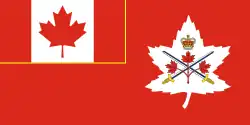 |
The Canadian Army (French: Armée canadienne) is the command responsible for the operational readiness of the conventional ground forces of the Canadian Armed Forces. It maintains regular forces units at bases across Canada, and is also responsible for the Army Reserve, the largest component of the Primary Reserve. The army is headed by the Commander of the Canadian Army and Chief of the Army Staff, who is subordinate to the Chief of the Defence Staff. The army is also supported by 3,000 civilian employees from the public service.
The army was formed in 1855, as the Active Militia, in response to the threat of the United States to the Province of Canada after the British garrison left for the Crimean War. This militia was later subdivided into the Permanent Active Militia and the Non-Permanent Active Militia. Finally, in 1940, an order in council changed the name of the Active Militia to the Canadian Army.
On 1 April 1966, prior to the unification of the Canadian Armed Forces, the land forces were placed under a new command called Mobile Command (French: Commandement des forces mobiles).[10] For two years following, the army existed as a distinct legal entity before its amalgamation with the Royal Canadian Navy and the Royal Canadian Air Force to form the Canadian Armed Forces. In the 1990s, the command was renamed Land Force Command (French: Commandement des Forces terrestres), until it reverted to its original name in August 2011.[11]
During its history, the Canadian Army has fought in a variety of conflicts, including in the North-West Rebellion, the Second Boer War, the First and Second World Wars, Korean War, and more recently with the Gulf War, and in the War in Afghanistan.
History
Formation
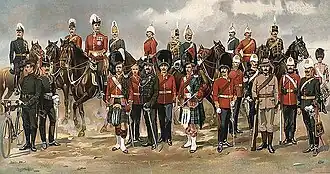
Prior to Confederation in 1867, the British Army, which included both "Fencible" Regiments of the British Army—recruited within British North America exclusively for service in North America—and Canadian militia units, was responsible for the defence of Canada. Some current regiments of the Canadian Army trace their origins to these pre-Confederation militia and Fencible units. Following the passage of the Militia Act of 1855, the Permanent Active Militia was formed, and in later decades several regular bodies of troops were created, their descendants becoming the Royal Canadian Horse Artillery, the Royal Canadian Dragoons, and the Royal Canadian Regiment. The major operations that regular Canadian troops, in the 19th century, participated in included: the North-West Rebellion in 1885, and the Second Boer War.

World Wars
During the First World War, the Canadian Army raised the volunteer Canadian Expeditionary Force (CEF) for service overseas, and was the primary Canadian participation to the war effort.[12][13][14]
The Canadian Army also fought during the Second World War. Following the declaration of war on Nazi Germany and her allies by the United Kingdom on 3 September 1939, with Prime Minister William Lyon Mackenzie King consulting with the Parliament of Canada and declaring war on 10 September 1939, the Canadian Army raised the Canadian Active Service Force, which initially consisted of the 1st Canadian Division; later increased to form the First Canadian Army.[15] On 19 November 1940, during Second World War, an Order in Council was issued that renamed the Permanent Active Militia as the Canadian Army (Active), supplemented by the Non-Permanent Active Militia, which was named the Canadian Army (Reserve).[4]
Post-war era and recent history (1945-present)
The Army participated in the Korean War, with the first elements of its participation landed in Korea in December 1950 and formed part of the forces who took part in Operation Killer and the Battle of Kapyong. Canadian troops were also committed to the NATO presence in West Germany during the Cold War.
In the years following its unification with the navy and air force in 1968, the size of Canada's land forces was reduced, however, Canadian troops participated in a number of military actions with Canada's allies. These operations included the Gulf War in 1991 and the invasion of Afghanistan in 2001, in addition to various peacekeeping operations under United Nations auspices in different parts of the world.[16] Despite Canada's usual support of British and American initiatives, Canada's land forces did not directly participate in,the Vietnam War, or the Iraq War.[17]
Structure
The Canadian Army is the land component of the Canadian Armed Forces, and the CAF's largest element. Command is held by the commander of the Canadian Army, a lieutenant-general, with a major-general serving as their deputy.[18][19] The commander of the Canadian Army reports to the chief of the Defence Staff, who, in turn, reports to the minister of National Defence, the head of the Department of National Defence.[18]
The Army is made up of four geographically based divisions and a training formation, the Canadian Army Doctrine and Training Centre (CADTC). CADTC is responsible for the development of doctrine, manages the Army's intellectual growth, and oversees all individual and collective training across its establishments and divisions. These four divisions and CADTC report to Canadian Army Headquarters, which is organized into three main sections: Operations, Strategy, and Reserve, each led by a brigadier-general.[19]
Regular Force and Army Reserve
Army personnel and units are organized into Regular Force and the Canadian Army Reserve.[20] The Regular Force is made up of officers and non-commissioned members enrolled for continuing, full-time military service.[21]
.jpg)
The Army Reserve, also known as the militia, is made up of officers and non-commissioned members enrolled for service other than continuing, full-time military service,[21] including subcomponents like the Canadian Rangers,[20] and provides a basis for national mobilization.[22] Army Reserve personnel are spread throughout ten Canadian Brigade Groups that are primarily made up of reservists, although each unit includes small cadre of Regular Force personnel for administrative and training support.[19]
Reservists usually serve part-time but may volunteer for full-time duty, helping augment Regular Forces' domestic and overseas deployments.[22][23] In addition to supporting the Regular Force, Reserve Force brigade groups maintain readiness to respond to natural disasters and other domestic emergencies within their regions.[22]
Divisions
The Army's four divisions are the 2nd Canadian Division, the 3rd Canadian Division, the 4th Canadian Division, and the 5th Canadian Division. The 1st Canadian Division was formerly a joint operations command within the Army, although it was transferred to the Canadian Joint Operations Command in 2015.[19][20]

Three of the four divisions have a combat mechanized brigade group, which is commanded by a colonel and manned by full-time, Regular Force personnel. Each mechanized brigade group includes two mechanized and one light infantry battalion, a support battalion, and regiments and units from the Royal Canadian Armoured Corps, Canadian Military Engineers, Royal Regiment of Canadian Artillery, Communications and Electronics Branch. Most divisions also have a company from Intelligence Branch and Canadian Ranger patrols.[19]
In addition to combat mechanized brigade groups, each division includes a combat service support brigade, companies from the Canadian Intelligence Corps, Canadian Ranger patrol groups, and several Reserve Force brigade groups, known as Canadian Army Reserve brigade groups. The composition of Army Reserve brigade groups is not standardized due to the reserve's historical roots in locally raised militia, although they typically field regiments of the Royal Canadian Infantry Corps, as well as armoured reconnaissance and artillery regiments. Collectively, these brigade groups include 17 armoured regiments and one independent armoured squadron, 16 artillery regiments and three independent artillery batteries, and 51 infantry battalions.[19]
Military police regiments are generally situated with a division and placed under its operational control, although they are not an formally a component of the division.[19]
2nd Canadian Division
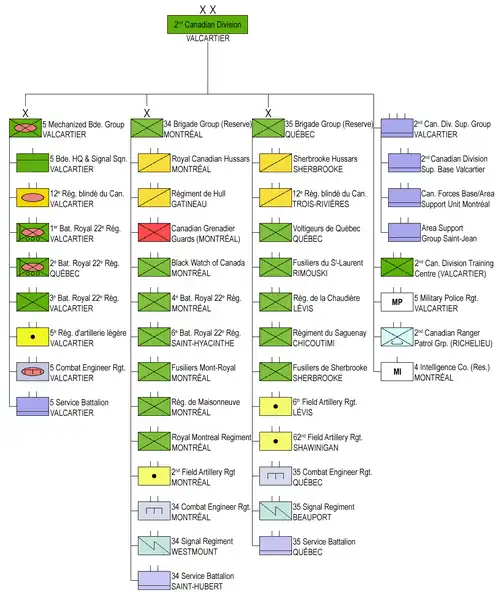
The 2nd Canadian Division is a formation that includes all Regular and Reserve units within Quebec. There are four main formations that make up the division:[24]
- 5 Canadian Mechanized Brigade Group (5 CMBG)
- 34 Canadian Brigade Group (34 CBG)
- 35 Canadian Brigade Group (35 CBG)
- 2nd Canadian Division Support Group
5 CMBG has close to 4,800 Regular and Reserve forces and is equipped with approximately 1,200 vehicles.[25] The two other brigade groups are Army Reserve formations. 34 Canadian Brigade Group comprises 2,500 reservists across 15 regiments, nine of which are based on the island of Montreal. 35 Canadian Brigade Group includes 2,200 reservists distributed among 12 units throughout eastern Quebec.[26][27]
Additionally, the following units report directly to the division's headquarters at 2nd Canadian Division Support Base Valcartier, Detachment Montreal:
- 2nd Canadian Division Training Center
- 4 Intelligence Company
- 5 Military Police Regiment
- 2nd Canadian Ranger Patrol Group
Training for the division takes place at Canadian Forces Leadership and Recruit School and the 2nd Canadian Division Training Centre.[24]
3rd Canadian Division
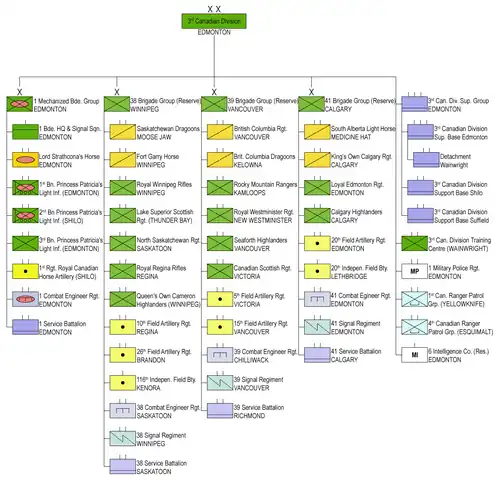
The 3rd Canadian Division is a formation that includes all Regular and Reserve units within western Canada and northwestern Ontario, except for CFB Wainwright, which is administered by the Canadian Army Training and Doctrine Centre. As of 2025, there are approximately 5,800 Regular Force soldiers and 5,300 Reserve Force soldiers, and 3,000 Canadian Rangers under the division. Additionally, the division employs approximately 1,000 civilians. The five major formations that make up the division are:[28]
- 1 Canadian Mechanized Brigade Group
- 38 Canadian Brigade Group (38 CBG)
- 39 Canadian Brigade Group (39 CBG)
- 41 Canadian Brigade Group (41 CBG)
- 3rd Canadian Division Support Group
38 CBG is made up of units based throughout Saskatchewan, Manitoba, and northwestern Ontario, 39 CBG is made up of units based in British Columbia, and 41 CBG is made up of units based in Alberta and the Northwest Territories.[29][30][31]
Additionally, the following units reports directly to the division's headquarters at CFB Edmonton:[28]
- 6 Intelligence Company
- 1 Military Police Regiment
- 3rd Canadian Division Training Centre
- 1st Canadian Ranger Patrol Group
- 4th Canadian Ranger Patrol Group
4th Canadian Division
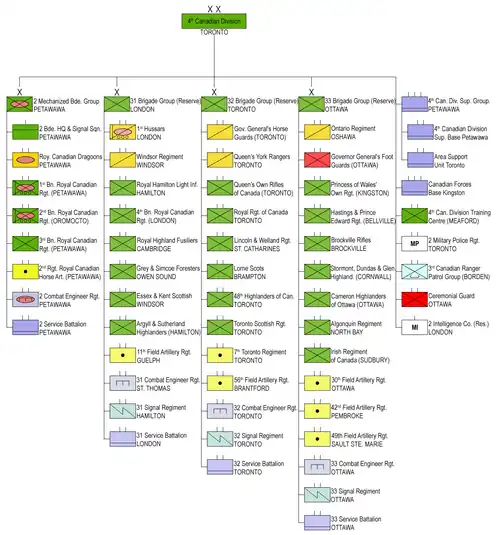
The 4th Canadian Division is a formation that includes all Regular and Reserve units within Ontario, excluding parts of northwestern Ontario, whose units form a part of 3rd Canadian Division. The division's units are spread across 46 Ontario communities, and comprises 5,880 Regular Force members, 5,980 Reserve Force members, and 620 Canadian Rangers as of 2025. Additionally the division employs 1,140 civilians. The largest concentrations of the division includes Garrison Petawawa and CFB Kingston.[32] The division has five major formations:[33]
- 2 Canadian Mechanized Brigade Group
- 31 Canadian Brigade Group (31 CBG)
- 32 Canadian Brigade Group (32 CBG)
- 33 Canadian Brigade Group (33 CBG)
- 4th Canadian Division Support Group
31 CBG Army Reserve Formation is headquartered in London and includes nearly 2,500 members across 12 units spread throughout southwestern Ontario and parts of central Ontario.[34] 32 CBG is made up of 3,000 soldiers in 14 units based in the Greater Golden Horseshoe.[35] 33 CBG is a military formation that includes 16 Army Reserve units spread across eastern and northeastern Ontario.[36]
In addition to its brigade and support groups, several other formations and units report directly to the division headquarters at Denison Armoury in Toronto:[33]
- 4th Canadian Division Training Centre
- 2 Military Police Regiment
- Ceremonial Guard
- 2 Intelligence Company
- 3rd Canadian Ranger Patrol Group
The Ceremonial Guard is administratively a subunit of the Governor General's Foot Guards (GGFG), but is made up of volunteers from the Regular and Reserve Force across all elements of the Canadian Armed Forces. The Ceremonial Guard are uniformed after the GGFG and the Canadian Grenadier Guards, the two regiments traditionally responsible for such duties in Ottawa.[37]
5th Canadian Division
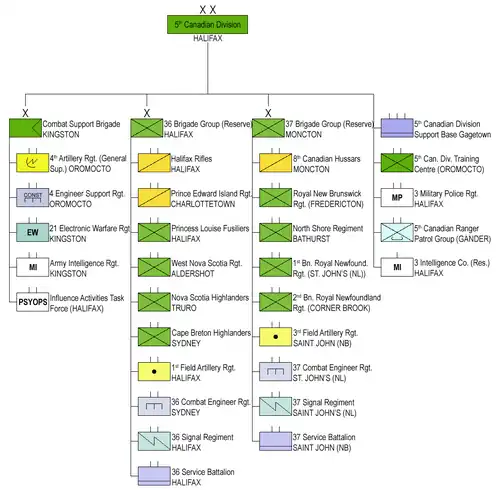
The 5th Canadian Division is responsible for Canadian Army units and activities in Atlantic Canada. It comprises 2 Regular Force units, 20 Reserve Force units, 4 mixed-force units, and a Canadian Ranger patrol group. The division operates five bases and garrisons in the region. As of 2025, it includes 2,151 Regular Force members, 2,791 Reserve Force members, 1,032 Canadian Rangers, and 673 civilian personnel. Although based in Atlantic Canada, its personnel also operate from Kingston, Ontario.[38]
The division includes two brigade groups: 36 Canadian Brigade Group, headquartered in Halifax, Nova Scotia, and 37 Canadian Brigade Group, headquartered in Moncton, New Brunswick. In addition to the two brigade groups, there are eight units that report directly to division headquarters in Halifax:[39]
- 21 Electronic Warfare Regiment
- 5th Canadian Division Support Base Gagetown
- 4th Artillery Regiment (General Support), RCA
- 4 Engineer Support Regiment
- 5th Canadian Division Training Centre
- 3 Intelligence Company
- 5th Canadian Ranger Patrol Group
- Influence Activities
Personnel
As of 2024, the Canadian Army included 22,500 full-time soldiers in the Regular Force. In the same year the Reserve Force had 21,500 part-time soldiers, including 5,300 Canadian Rangers. In addition to commissioned and non-commissioned members, the Army employs 3,500 civilian personnel to support its operations.[6]
Rank and insignia
Military ranks in the Canadian Army denote an individual's position within the Army's hierarchy. Advancement through the ranks corresponds to increased responsibility and authority. The rank structure is used to facilitate the transmission of orders during operations, ensure clarity of command, and maintain discipline and order.[40]
Commander-in-Chief
In their capacity as the Commander-in-Chief of Canada, the governor general of Canada is entitled to wear a distinctive general officer uniform from any of the Canadian Armed Forces commands, including the Canadian Army. This uniform features a unique general sleeve braid embellished with the governor general's badge. The badge is also embroidered on the uniform’s shoulder straps.[41]
| Governor General[42] | |
|---|---|
.svg.png) |
.svg.png)
|
| Board | Sleeve |
Officers
Army officers hold positions of command and responsibility. Their roles typically include overseeing personnel, planning, and directing operations, making decisions within their scope of authority, and providing advice to achieve operational objectives.[43]
The rank insignia for Army general officers, like those of other Canadian Armed Forces general and flag officers, features maple leaves, the number of which corresponds to the officer's rank.[44][45] The rank insignia for senior officers generally consists of a combination of pips and St. Edward's Crown, although the insignia for majors only includes the crown. The insignia for junior and subordinate officers/officer cadets consists solely of pips, with the number corresponding to the officer's rank.[45][46]
| NATO code | OF-10 | OF-9 | OF-8 | OF-7 | OF-6 | OF-5 | OF-4 | OF-3 | OF-2 | OF-1 | ||||||||||||||
|---|---|---|---|---|---|---|---|---|---|---|---|---|---|---|---|---|---|---|---|---|---|---|---|---|

|

|

|

|

|

|

|

|

|

| |||||||||||||||
| General | Lieutenant-general | Major-general | Brigadier-general | Colonel | Lieutenant-colonel | Major | Captain | Lieutenant | Second lieutenant | |||||||||||||||
| Général(e) | Lieutenant(e)-général(e) | Major(e)-général(e) | Brigadier(ère)-général(e) | Colonel(le) | Lieutenant(e)-colonel(le) | Major(e) | Capitaine | Lieutenant(e) | Sous-lieutenant(e) | |||||||||||||||
Non-commissioned members
Non-commissioned members in the Army perform operational and support duties and contribute to maintaining safety, discipline, and the welfare of their units.[43]
Although private is the lowest rank specified in the National Defence Act, some Army units use alternative titles for the rank of private for regimental or historical reasons.[49] Several infantry units use alternate titles for the rank of private, including guardsman in regiments of foot guards, fusilier in fusilier units, and rifleman or voltigeur in rifle regiments. The lowest rank is trooper in the armoured corps, gunner for artillery units, signaller for the signals corps, and ranger for the Canadian Rangers. The Canadian Military Engineers use sapper as their lowest rank, while the Corps of Royal Canadian Electrical and Mechanical Engineers uses craftsman. In military bands, the lowest rank is musician, piper, or drummer, depending on the band type and instrument.[49][50]
| NATO code | OR-9 | OR-8 | OR-7 | OR-6 | OR-5 | OR-4 | OR-3 | OR-2 | OR-1 | |||||||||||||||||||||||||||
|---|---|---|---|---|---|---|---|---|---|---|---|---|---|---|---|---|---|---|---|---|---|---|---|---|---|---|---|---|---|---|---|---|---|---|---|---|
.svg.png)
|
.svg.png)
|
.svg.png)
|
No insignia | |||||||||||||||||||||||||||||||||
| Chief warrant officer | Master warrant officer | Warrant officer | Sergeant | Master corporal | Corporal | Private (trained) | Private (basic) | |||||||||||||||||||||||||||||
| Adjudant(e)-chef | Adjudant(e)-maître | Adjudant(e) | Sergent(e) | Caporal(e)-chef | Caporal(e) | Soldat(e) (formé(e)) | Soldat(e) (confirmé(e)) | |||||||||||||||||||||||||||||
In addition to rank insignias, non-commissioned members appointed as the Canadian Forces Chief Warrant Officer, Command Chief Warrant Officer, or Senior Appointment Chief Warrant Officer wear distinct insignias to denote the senior appointment. Leaders of military bands, such as drum, pipe, and trumpet/bugle majors, also wear distinctive insignia denoting their appointments.[45]
Training
Newly enrolled non-commissioned members of the Army undergo foundational training through Basic Military Qualification (BMQ), while newly enrolled officers go through Basic Military Officer Qualification (BMOQ). Both BMQ and BMOQ take place at Canadian Forces Leadership and Recruit School.[51][52]
Officer entry plans
The Canadian Army commissions officers through multiple entry plans, each designed for candidates with different educational backgrounds and levels of military experience, to develop them to the required standard of proficiency expected of an officer. This typically includes providing pathways to complete an academic degree. However, individuals who already possess an academic degree or technology diploma may qualify for the Direct Entry Officer Plan, which serves as a direct pathway to commissioning.[53]
Several entry plans offer paid or subsidized education in exchange for military service. The Regular Officer Training Plan involves earning an academic degree at the Royal Military College of Canada (RMC), the Royal Military College Saint-Jean (RMC Saint-Jean), or a civilian Canadian university.[54] Due to shortages in specific officer occupations, the Continuing Education Officer Training Plan (CEOTP) was created for select candidates who are otherwise qualified for service as officers but lack an academic degree, allowing them to enter the Army and complete their degree while serving.[55]
Several entry plans facilitate the transition of serving non-commissioned members to officers. The University Training Plan for Non-Commissioned Members allows serving members to earn a degree at RMC, RMC Saint-Jean, or a civilian Canadian university in preparation to become officers.[56] The Commissioning from the Ranks Plan commissions experienced candidates who demonstrate officer potential, supplementing other commissioning routes.[57] The Special Requirements Commissioning Plan leverages the skills of senior non-commissioned members, such as Chief Warrant Officers, and provides them a route to commissioning.[58]
Occupational training
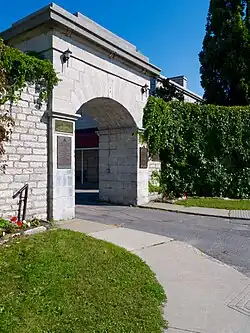
The Canadian Army Doctrine and Training Centre is the Army's formation tasked with training and developing military doctrine and oversees several training organizations and establishments, like the Peace Support Training Centre and the Canadian Army Command and Staff College.[59] The Army also operates several schools through the Combat Training Centre (CTC), including Canadian Army Advanced Warfare Centre and the Tactics School.[60]
Several unified Canadian Armed Forces schools are also accessible to Army personnel, including the Canadian Forces College and the CTC's Canadian Forces School of Military Engineering.[61][62][63] The latter institution was formerly an army run institution until 1968, when its mandate was expanded to meet the needs of the Navy and Air Force.[63]
Uniforms
Uniforms worn by the Canadian Army are regulated by the Dress Instructions for the Canadian Forces. Misuse of the likeness of Canadian Army uniforms is an offence under Article 419 of the Criminal Code of Canada and is punishable by summary conviction.[64]
Uniforms of the Canadian Armed Forces, including the Army, are categorized into five types, including No. 1 Dress (ceremonial dress), No. 2 Dress (mess dress), No. 3 Dress (service dress), No. 4 Dress (occupational dress), and No. 5 Dress (operational dress).[64] Each category contains several orders that specify variations for particular occasions.[65]
Daily duty and operational attire

No. 3 Dress is the Canadian Army's service dress uniform worn for daily duties and travel.[65] It includes a beret, necktie, service jacket, and trousers in Army environmental colours, paired with black leather shoes. Variations include No. 3A, a long-sleeved version, and No. 3B, a short-sleeved version.[66]
No. 4 Operational Dress consists of uniforms worn during operations, operational training, or as directed.[65] These include field combat clothing featuring CADPAT digital camouflage, as well as aviation and naval combat dress. Operational uniforms are used across the entire Canadian Armed Forces and are not specific to any single environmental command.[67]
Formal attire
.jpg)
No. 1 Dress includes uniforms for formal occasions, and whose appearance reflect the heritage of the unit.[65][68] The Army's service dress uniforms may also be used for formal occasions, with No. 1 Dress outlining its use when worn with medals and accoutrements, and No. 1A Dress outlining its use when worn with medals only.[68]
The Army's universal full dress uniform, No. 1B Dress, is the Army's most formal attire and includes a white Wolseley helmet, a red coat, and royal blue trousers. Most units are authorized some minor regimental differences to reflect the unit's history, although some units are authorized significant differences from the universal full dress. This includes changes to the headdress for artillery, hussar, horse guards, rifle, and kilted Irish and Canadian-Scottish regiments, as well as changes to the colour of the tunic or doublet. Unlike other uniforms in the CAF, which are issued, full dress uniforms are generally purchased by the service member, except for officer cadets at Canadian military colleges and volunteers to the Ceremonial Guard, for whom they are provided.[68]
No. 2 Dress is a uniform worn for military dinners and other formal evening events. The standard pattern includes a red mess jacket, blue waistcoat, and either trousers or a kilt. Similar to full dress uniforms, several Army units have authorized regimental variations to their mess dress.[69]
Equipment
Vehicles

The Canadian Army operates a variety of vehicles including the Leopard 2 series main battle tank, which includes variants such as the Leopard 2A4, 2A4M, 2A6M. These tanks are primarily deployed to provide direct fire support.[70] They are supported by LAV 6 infantry fighting vehicles, which offer enhanced fire support, protection, and mobility for infantry.[71] Armoured reconnaissance and command and control vehicles in use include the Coyote armoured vehicle and the Textron tactical armoured patrol vehicle.[72][73]
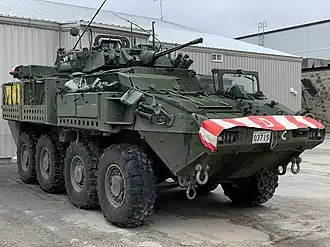
Other vehicles the Canadian Army uses for personnel transport and logistics includes the amphibious Bandvagn 206 and the G Wagon - Light Utility Vehicle Wheeled. Armoued support vehicles in use include the Armoured Combat Support Vehicle and the Leopard 2ARV and 2AEV variants, the latter two used for armoured recovery and engineering purposes.[70][74] Other support vehicles include the Light Support Vehicle Wheeled, Medium Support Vehicle System, and the Heavy Logistics Vehicle Wheeled.[74]
The army also operates several specialized armored vehicles for demining and route clearance, including the Buffalo, and Husky VMMD. For transport, route opening personnel utilize the Cougar mine-resistant ambush protected vehicle.[74]
Weapons
The Canadian Army's standard issue weapon is the 5.56 mm Colt Canada C7 and C8 rifles, while the C22 pistol is the standard sidearm. The C7A2 serves as the standard personal assault rifle, while the C8A3 carbine is used when space constraints limit the use of the C7A2.[75][76]
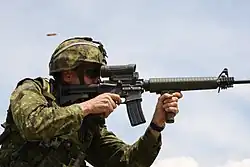
The .50 calibre C15A2 is the designated long-range sniper weapon of the Canadian Army, while the Colt Canada C20 DMR is the designated marksman rifle.[75] Weapons used to provide support and sustained fire include the C9A2 light machine gun, C6A1 general-purpose machine gun, and the M2HB heavy machine gun.[75][77][78] Other weapons used by Canadian soldiers include the 81mm mortar for indirect fire and the M72 LAW anti-tank weapon.[75]
The Canadian Army has two artillery systems, the C3 105mm howitzer and the M777 155mm howitzer.[75] The former provides close fire support while the latter system can provide fire support as far as 40 kilometres (25 mi).[79][80] The M777 howitzer is also able to be combined with the M982 Excalibur guided artillery shell, providing accurate fire up to 30 kilometres (19 mi) away.[80]
Bases and facilities
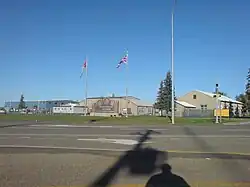
There are 10 Canadian Forces Bases that the Canadian Army uses to house brigade groups and regiments, as well as to provide training and support facilities for its personnel.[81] This includes CFB Gagetown in New Brunswick, CFB Valcartier in Quebec, CFB Petawawa, CFB Kingston and CFB Toronto in Ontario, CFB Shilo in Manitoba, and CFB Edmonton and CFB Suffield in Alberta.[81][82] CFB Suffield is the largest Canadian Army base, hosting the Army's largest military training area, as well as the British Army Training Unit Suffield.[83] Alongside these 10 Canadian Forces Bases, the Canadian Army also operates several detachments and support bases, like 3rd Canadian Division Support Base Detachment Wainwright.[81]
.jpg)
Canadian Army Headquarters, the central administrative and command location for the Canadian Army, is located at NDHQ Carling in Ottawa.[84] The headquarters for the 2nd Canadian Division is located at 2nd Canadian Division Support Base Valcartier, Detachment Montreal,[85] while the 3rd Canadian Division is headquartered at CFB Edmonton.[86] The 4th Canadian Division operates from Denison Armoury at CFB Toronto, and the 5th Canadian Division is headquartered at CFB Halifax,[87][84] which primarily serves as a Royal Canadian Navy installation.[88]
In addition to Canadian Forces bases, the Canadian Army Reserve maintains armouries across Canada. Approximately 97 per cent of Canadians live within 45 minutes of a Canadian Army Reserve armoury.[89]
Badge
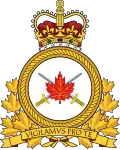
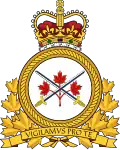
The badge of the Canadian Army consists of:[90]
- St. Edward's Crown
- Three red maple leaves on one stem
- Crossed swords
Canadian Army Journal
Since 1947, the Canadian Army has produced a peer-reviewed academic journal called the Canadian Army Journal. In 1965, prior to the unification of the Canadian Armed Forces, the journal was merged with similar publications from across the services. In 1980, the Canadian Army Doctrine Bulletin began printing as the successor to the original journal, and in 2004 the publication returned to its original name.[91]
See also
- ABCANZ Armies
- Arctic Response Company Group
- Canadian Army Trophy
- Canadian military bands
- Canadian Special Operations Forces Command
- Formation patches of the Canadian Army
- Regimental nicknames of the Canadian Forces
- Soldier Apprentice
- Supplementary Order of Battle
References
Citations
- ^ An Act to regulate the militia of this province and to repeal the acts now in force for that purpose [microform]: assented to 19th of May, 1855. S. Derbyshire and G. Desbarats. ISBN 9780665504136. Retrieved 26 March 2020 – via Archive.org.
- ^ "War Of 1812 Battle Honours". www.forces.gc.ca. Ministry of National Defence. 14 September 2012. Archived from the original on 20 September 2020. Retrieved 9 March 2020.
- ^ Morton, Desmond (2009). A Military History of Canada. McClelland & Stewart. p. 91. ISBN 978-1-5519-9140-5.
- ^ a b Stacey, Charles Perry (1955). "The Army Programme for 1941" (PDF). Official History of the Canadian Army in the Second World War Volume I: The Army in Canada, Britain and the Pacific. Ministry of National Defence (Canada). p. 89.
- ^ "Canadian Army collection" (PDF). University of Victoria Special Collections: Introduction. 1899–1984. Retrieved 24 March 2020.
The Canadian Army was established in 1855 when the government passed the Militia Act, which provided for a paid, regular army consisting of active volunteer militia. Its forerunner was the militia dating back to 1651.
- ^ a b "About the Canadian Armed Forces". www.forces.gc.ca. Government of Canada. 25 February 2013. Retrieved 20 September 2023.
- ^ "Canadian Army". Ottawa: Her Majesty the Queen in Right of Canada. 2013. Archived from the original on 2 May 2017. Retrieved 14 February 2017.
- ^ "Canadian Army". www.gg.ca. Governor General of Canada. 15 March 2018. Retrieved 18 August 2025.
- ^ "Juno the Canadian Army Mascot". www.canada.ca. Government of Canada. 4 June 2021. Retrieved 9 December 2022.
- ^ Dunn, Brittany (2023). "A Documentary History of the Badge of the Canadian Army". Canadian Military History. 32 (2) – via Scholars Commons @ Laurier.
- ^ "Navy and air force to be royal once again". CBC News. 16 August 2011. Archived from the original on 10 November 2012. Retrieved 15 August 2011.
- ^ "Soldiers of the First World War - CEF". Archived from the original on 7 September 2013. Retrieved 10 September 2013.
- ^ "History & Heritage". Canadian Army. 25 February 2013. Archived from the original on 15 July 2013. Retrieved 11 January 2021.
- ^ Nicholson 1962.
- ^ Stacy 1956.
- ^ "Canada in Afghanistan: Overview of Military and Development Activities". 23 October 2010. Archived from the original on 24 September 2013. Retrieved 10 September 2013.
- ^ "Canada's 'No' To Iraq War A Defining Moment For Prime Minister, Even 10 Years Later". 19 March 2013. Archived from the original on 20 July 2013. Retrieved 10 September 2013.
- ^ a b "Organizational structure of the Department of National Defence and the Canadian Armed Forces". www.canada.ca. Government of Canada. 8 August 2024. Retrieved 10 August 2025.
- ^ a b c d e f g Boileau, John (10 September 2024). "Canadian Army Organization". thecanadianencyclopedia.ca. Historica Canada. Retrieved 13 August 2025.
- ^ a b c "The Canadian Army of Today". www.canada.ca. Government of Canada. 6 February 2024. Retrieved 10 August 2025.
- ^ a b "National Defence Act (R.S.C., 1985, c. N-5)". laws-lois.justice.gc.ca. 31 July 2025. Retrieved 17 August 2025.
- ^ a b c "32 Canadian Brigade Group". www.canada.ca. Government of Canada. 28 January 2025. Retrieved 17 August 2025.
- ^ "Ways to Join". forces.ca. Retrieved 17 August 2025.
- ^ a b "2nd Canadian Division - Quebec". www.canada.ca. Government of Canada. 10 April 2025. Retrieved 10 August 2025.
- ^ "5 Canadian Mechanized Brigade Group". www.canada.ca. Government of Canada. 8 July 2024. Retrieved 10 August 2025.
- ^ "34 Canadian Brigade Group". www.canada.ca. Government of Canada. 1 October 2024. Retrieved 10 August 2025.
- ^ "35 Canadian Brigade Group". www.canada.ca. Government of Canada. 10 July 2024. Retrieved 10 August 2025.
- ^ a b "3rd Canadian Division - Western Canada". www.canada.ca. Government of Canada. 28 July 2025. Retrieved 10 August 2025.
- ^ "38 Canadian Brigade Group". www.canada.ca. Government of Canada. 9 May 2025. Retrieved 17 August 2025.
- ^ "39 Canadian Brigade Group". www.canada.ca. Government of Canada. 27 November 2024. Retrieved 17 August 2025.
- ^ "41 Canadian Brigade Group". www.canada.ca. Government of Canada. 21 June 2025. Retrieved 17 August 2025.
- ^ "4th Canadian Division - Ontario". www.canada.ca. Government of Canada. 16 July 2025. Retrieved 17 August 2025.
- ^ a b "Units and Formations - 4th Canadian Division". www.canada.ca. Government of Canada. 16 July 2025. Retrieved 15 February 2023.
- ^ "31 Canadian Brigade Group". www.canada.ca. Government of Canada. 20 March 2025. Retrieved 17 August 2025.
- ^ "32 Canadian Brigade Group". www.canada.ca. Government of Canada. 28 January 2025. Retrieved 17 August 2025.
- ^ "33 Canadian Brigade Group". www.canada.ca. Government of Canada. 19 September 2024. Retrieved 17 August 2025.
- ^ "Ceremonial Guard". www.canada.ca. Government of Canada. 17 July 2025. Retrieved 17 August 2025.
- ^ "5th Canadian Division". www.canada.ca. Government of Canada. 28 February 2025. Retrieved 17 August 2025.
- ^ "Units and Formations - 5th Canadian Division". www.canada.ca. Government of Canada. 27 February 2023. Retrieved 17 August 2025.
- ^ "Ranks and appointment". www.canada.ca. Government of Canada. 30 August 2023. Retrieved 10 August 2025.
- ^ "Governor General and Commander-in-Chief of Canada". www.canada.ca. Government of Canada. 10 October 2017. Retrieved 10 August 2025.
- ^ "Dress instructions | Section 2 Rank insignia and appointment badges". canada.ca. 1 February 2024. Retrieved 21 October 2024.
- ^ a b "Joining the Canadian Armed Forces". forces.ca. Government of Canada. Retrieved 10 August 2025.
- ^ Rehman, Mishall (5 April 2016). "General Officer Rank Insignia to change". www.cmfmag.ca. Canadian Military Family Magazine. Retrieved 10 August 2025.
- ^ a b c "Canadian Army ranks and badges". www.canada.ca. Government of Canada. 14 November 2023. Retrieved 10 August 2025.
- ^ Cudmore, James (19 June 2014). "Canadian Forces' return to old-style ranks, insignia costs millions". www.cbc.ca. Canadian Broadcasting Corporation. Retrieved 10 August 2025.
- ^ a b "Ranks and appointment". canada.ca. Government of Canada. Archived from the original on 3 July 2025. Retrieved 28 May 2021.
- ^ a b "The Canadian Armed Forces modernizes military ranks in French". Canada. Government of Canada. 3 February 2022. Archived from the original on 28 March 2025. Retrieved 7 April 2024.
- ^ a b "QR&O: Volume I - Chapter 3 Rank, Seniority, Command and Precedence". www.canada.ca. Government of Canada. 28 November 2022. Retrieved 10 August 2025.
- ^ "Heritage Structure - Annex A – Short Forms of Address". www.canada.ca. Government of Canada. 29 October 2024. Retrieved 10 August 2025.
- ^ "Training for officers". www.canada.ca. Government of Canada. 9 November 2018. Retrieved 10 August 2025.
- ^ "Joining the Canadian Armed Forces". forces.ca. Canadian Amed Forces. Retrieved 11 August 2025.
- ^ "DAOD 5002-2, Direct Entry Officer Plan - Regular Force". www.canada.ca. Government of Canada. 13 December 2018. Retrieved 10 August 2025.
- ^ "Regular Officer Training Plan". forces.ca. Canadian Amed Forces. Retrieved 10 August 2025.
- ^ "DAOD 5002-6, Continuing Education Officer Training Plan – Regular Force". www.canada.ca. Government of Canada. 10 December 2024. Retrieved 10 August 2025.
- ^ "DAOD 5002-9, University Training Plan for Non-Commissioned Members – Regular Force". www.canada.ca. Government of Canada. 10 December 2024. Retrieved 10 August 2025.
- ^ "DAOD 5002-10, Commissioning from the Ranks Plan". www.canada.ca. Government of Canada. 10 December 2024. Retrieved 10 August 2025.
- ^ "DAOD 5002-11, Special Commissioning Plan". www.canada.ca. Government of Canada. 10 December 2024. Retrieved 10 August 2025.
- ^ "Canadian Army Doctrine and Training Centre (CADTC)". www.canada.ca. Government of Canada. 18 December 2024. Retrieved 10 August 2025.
- ^ "Combat Training Centre". www.canada.ca. Government of Canada. 18 December 2024. Retrieved 10 August 2025.
- ^ "About the Canadian Forces College". www.canada.ca. Government of Canada. 19 August 2024. Retrieved 10 August 2025.
- ^ "Canadian Armed Forces schools and training establishments". www.canada.ca. Government of Canada. 14 June 2022. Retrieved 11 August 2025.
- ^ a b "The Schools of Military Engineering". cmea-agmc.ca. The Canadian Militar Engineers Association. 2023. Retrieved 11 August 2025.
- ^ a b "Dress instructions - Chapter 2 Uniform, Dress and appearance Section 1 Uniform and Dress". www.canada.ca. Government of Canada. 4 March 2025. Retrieved 11 August 2025.
- ^ a b c d "Dress instructions - Annex A Categories and orders of dress". www.canada.ca. Government of Canada. 12 November 2024. Retrieved 11 August 2025.
- ^ "Dress instructions - Annex C Service dress – No. 3". www.canada.ca. Government of Canada. 12 March 2024. Retrieved 11 August 2025.
- ^ "Dress instructions - Annex D Operational dress". www.canada.ca. Government of Canada. 30 August 2023. Retrieved 11 August 2025.
- ^ a b c "Dress instructions - Chapter 6 Full dress and undress uniforms". www.canada.ca. Government of Canada. 19 January 2024. Retrieved 11 August 2025.
- ^ "Dress instructions - Annex B Appendix 1 Branch and regimental nos. 2 and 2a orders of dress". www.canada.ca. Government of Canada. 30 August 2023. Retrieved 11 August 2025.
- ^ a b "Leopard 2 Family of Vehicles". www.canada.ca. Government of Canada. 10 February 2021. Retrieved 5 August 2025.
- ^ "Leopard 2 Family of Vehicles". www.canada.ca. Government of Canada. 10 February 2021. Retrieved 5 August 2025.
- ^ "Coyote". www.canada.ca. Government of Canada. 10 February 2021. Retrieved 5 August 2025.
- ^ "Tactical Armoured Patrol Vehicle (TAPV)". www.canada.ca. Government of Canada. 11 August 2021. Retrieved 5 August 2025.
- ^ a b c "Vehicles". www.canada.ca. Government of Canada. 14 April 2021. Retrieved 5 August 2025.
- ^ a b c d e "Weapons". www.canada.ca. Government of Canada. 16 February 2021. Retrieved 5 August 2025.
- ^ "C8A3 Carbine Automatic Rifle". www.canada.ca. Government of Canada. 16 February 2021. Retrieved 5 August 2025.
- ^ "FN Herstal M2HB-QCB .50-Cal. Heavy Machine Gun". www.canada.ca. Government of Canada. 22 August 2021. Retrieved 5 August 2025.
- ^ "C6 and C6A1 7.62-mm Medium Machine Gun". www.canada.ca. Government of Canada. 16 February 2021. Retrieved 5 August 2025.
- ^ "C3 105-mm Howitzer". www.canada.ca. Government of Canada. 16 February 2021. Retrieved 5 August 2025.
- ^ a b "M777 Howitzer". www.canada.ca. Government of Canada. 16 February 2021. Retrieved 5 August 2025.
- ^ a b c "Bases and Units". www.canada.ca. Government of Canada. 26 May 2021. Retrieved 6 August 2025.
- ^ "Canadian Armed Forces Footprint". www.canada.ca. Government of Canada. 17 April 2025. Retrieved 6 August 2025.
- ^ "Canadian Forces Base, Suffield". www.canada.ca. Government of Canada. 16 July 2021. Retrieved 6 August 2025.
- ^ a b "Media contact list for the Department of National Defence". www.canada.ca. Government of Canada. 3 January 2024. Retrieved 6 August 2025.
- ^ "Organization Information 2nd Canadian Division Headquarters". www.canada.ca. Government of Canada. 6 August 2025. Retrieved 6 August 2025.
- ^ "3rd Canadian Division - Western Canada". www.canada.ca. Government of Canada. 28 July 2025. Retrieved 6 August 2025.
- ^ "4th Canadian Division - Ontario". www.canada.ca. Government of Canada. 24 March 2022. Retrieved 6 August 2025.
- ^ "MARLANT Units". www.canada.ca. Government of Canada. 13 December 2019. Retrieved 6 August 2025.
- ^ "Canadian Army Reserve Armouries across Canada get set to welcome the public". www.canada.ca. Government of Canada. 28 September 2017. Retrieved 6 August 2025.
- ^ "Approval of a Badge". Public Register of Arms, Flags and Badges of Canada. Official website of the Governor General. Retrieved 8 November 2021.
- ^ Canadian Army Journal Archived 2005-10-27 at the Wayback Machine
Notes
- ^ The Canadian Army originates from the Province of Canada's "Active Militia", created through the Militia Act of 1855. However, several Canadian Army units perpetuate the battle honours of Canadian units from the War of 1812.[2] The Active Militia was later adopted by the Canadian confederation through the Militia Act of 1868.[3] In 1940, an order in council renamed the Active Militia to the Canadian Army.[4] In 1968, the Canadian Army was formally amalgamated into the Canadian Armed Forces, serving as the forces' land component.
- ^ Province of Canada (1855–1867)
Bibliography
- Nicholson, G.W.L. (1962). Official History of the Canadian Army in the First World War: Canadian Expeditionary Force, 1914-1919 (PDF). Ottawa: Roger Duhamel, Queen's Printer and Controller of Stationery. Retrieved 9 November 2022.
- Stacy, C.P. (1 January 1956). Official History of the Canadian Army in the Second World War (PDF). Vol. I, Six Years of War. Ottawa: Queen's Printer. Retrieved 9 November 2022.
Further reading
- Kasurak, Peter. A National Force: The Evolution of Canada's Army, 1950–2000 (Vancouver: UBC Press, 2013)
External links
- Official website

- Faces of War: The Canadian Army at Library and Archives Canada
- army.ca - Army.ca, a web forum and interactive wiki dealing with both current and historical issues related to the Canadian Army.
- Battle Honours in the Canadian Army by J.R. Grodzinski
- Canadiansoldiers.com
- Salute to the Canadian Army
